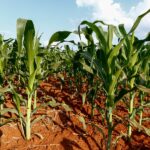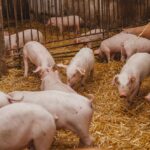When growing cassava in South Africa, there are several infections and diseases that farmers should watch out for. Cassava is susceptible to various pests, pathogens, and viral diseases. Here are some important ones to be aware of:
- Cassava Brown Streak Disease (CBSD): CBSD is a viral disease transmitted by whiteflies. It causes yellow or brown streaks on the cassava storage roots, making them inedible. Symptoms may also include leaf chlorosis and leaf necrosis. Planting resistant cassava varieties and controlling whiteflies through appropriate insecticide use are crucial for prevention.
- Cassava Mosaic Disease (CMD): CMD is caused by a group of viruses that are transmitted by whiteflies. Infected plants display mottled and distorted leaves, stunted growth, and reduced tuber formation. Planting CMD-resistant varieties and controlling whiteflies are essential preventive measures.
- Cassava Bacterial Blight (CBB): CBB is caused by the bacterium Xanthomonas axonopodis pv. manihotis. It affects the leaves, stems, and roots of cassava plants, resulting in wilting, leaf spots, stem cankers, and rotting roots. Promoting good field hygiene, using disease-free planting material, and avoiding overhead irrigation can help prevent CBB.
- Cassava Green Mite: This mite, also known as the two-spotted spider mite (Tetranychus urticae), is a common pest that attacks cassava leaves. It sucks sap from the leaves, causing them to turn yellow and eventually drop prematurely. Regular monitoring, early detection, and appropriate acaricide application are important for mite control.
- Root-Knot Nematodes: These microscopic worms (Meloidogyne spp.) infect the roots of cassava, causing the formation of characteristic knots or galls. Infected plants exhibit stunted growth, reduced yield, and nutrient deficiencies. Crop rotation, use of resistant varieties, and soil sanitation practices are essential for managing nematode populations.
It is crucial for cassava farmers to maintain good agricultural practices, including crop rotation, proper sanitation, regular monitoring for pests and diseases, and the use of disease-resistant varieties. Consultation with local agricultural extension services or experts can provide specific guidance on management strategies tailored to the region and prevailing conditions.
Join 'Farmers Mag' WhatsApp Channel
Get the latest Farming news and tips delivered straight to your WhatsApp
CLICK HERE TO JOIN






